“Then he knew though the mountain slept the winds
were shaping its peak to an arrowhead
poised
And now he could only
bar himself in and wait
for the great flint to come singing into his heart”
– Bushed, Earle Birney.
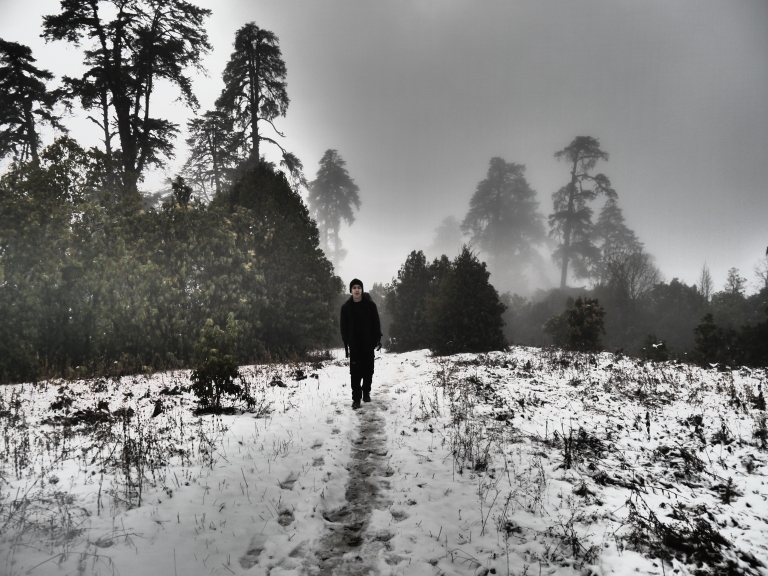
If you’ve got a few thousand dollars and a few spare months, you can climb Everest. You can hire yourself ten sherpas and three guides, you can buy yourself a copy of Mountaineering for Dummies, and you can pack your selfie-stick for the all-important summit photo. All it takes is a silly amount of time and money, and you can join the growing number of people who have made it to the highest point on Earth.
But in the same way that it’s not as impressive joining the mile-high club in your own private jet, climbing to the roof of the world because you’re willing to spunk $30,000 on the accolade can actually look like quite a shallow achievement.
With this in mind, when I went to the Himalayas, I wanted to properly lock horns with nature. I wanted to say I’d genuinely, independently conquered the tectonic titans of this world.
Mother Nature took up the challenge with gusto.
Getting from Kathmandu to the Himalayas is probably the most efficient way of destroying your spinal column, bar being hammered on the head continually with a mallet. Heading north the roads quickly deteriorated into moonscapes, so what was left of the suspension on our bus screamed in agony for 5 hours as Aneirin (my travel buddy) and I lost a few inches in height and a few thousand brain cells to the bus window.
On our arrival in Pokhara, a quaint town in the foothills of the Annapurna range, the sharp ‘fishtail’ mountain that dominates the magnificent landscape was veiled in cloud. Mother Nature was plotting.
Being serious and sensible people, Aneirin and I had prepared well for our 4-day trek. We bought some jazzy-looking jumpers in the markets of Kathmandu, but having been assured that it would not rain at that time of year (February) we avoided the extra 3 quid waterproofs. On top of this, we shopped candidly for a range of nutritional delights: biscuits, muffins, more biscuits, and two bottles of whiskey. We were set for the ascent.
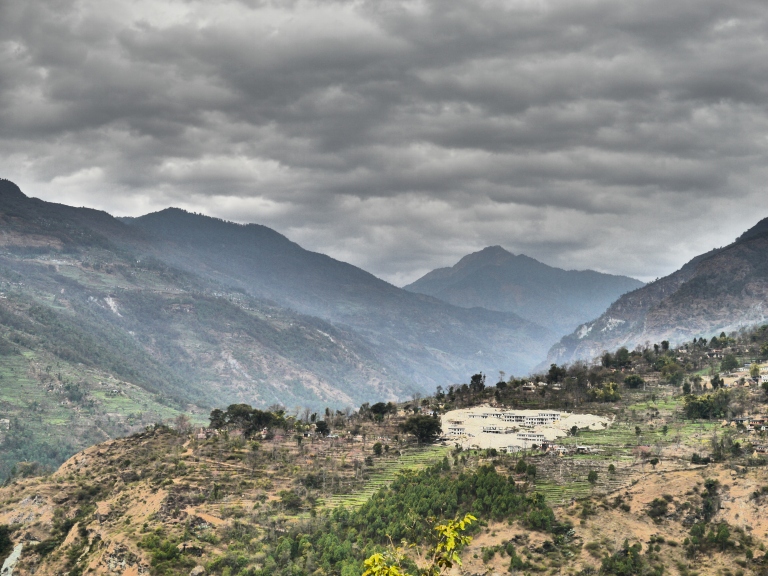
The first stage of our climb was kids’ stuff. We climbed 1,200m in little over 4 hours, stopping every now and then to consult our diabolically inadequate map. The only drama came, surreally, when a rampaging bull came tearing down the single-track towards us. We had about a second to make a decision:
Jump right: certain death down the cliff face.
Jump left: slam into a spiky granite wall and pray the bull could pass. Stay put: well, the bull wasn’t stopping.
We both leapt to the left and somehow the bull used the remaining inches of path to thunder by. Looking back, this was Mother Nature’s first warning shot. At the time, navigating the labyrinthine paths up the mountain, it felt like we’d just survived an encounter with the Minotaur.
At nightfall we arrived in a delightful mountainside village called Nangi. The final hour of our climb was uncomfortable; thick grey cloud rose from the valley below and engulfed us in sticky, icy water droplets that reduced visibility to about a foot. We managed to dry off by the fire in the house of a man named Pooni, who is probably the most cheerful and carefree man in the world.
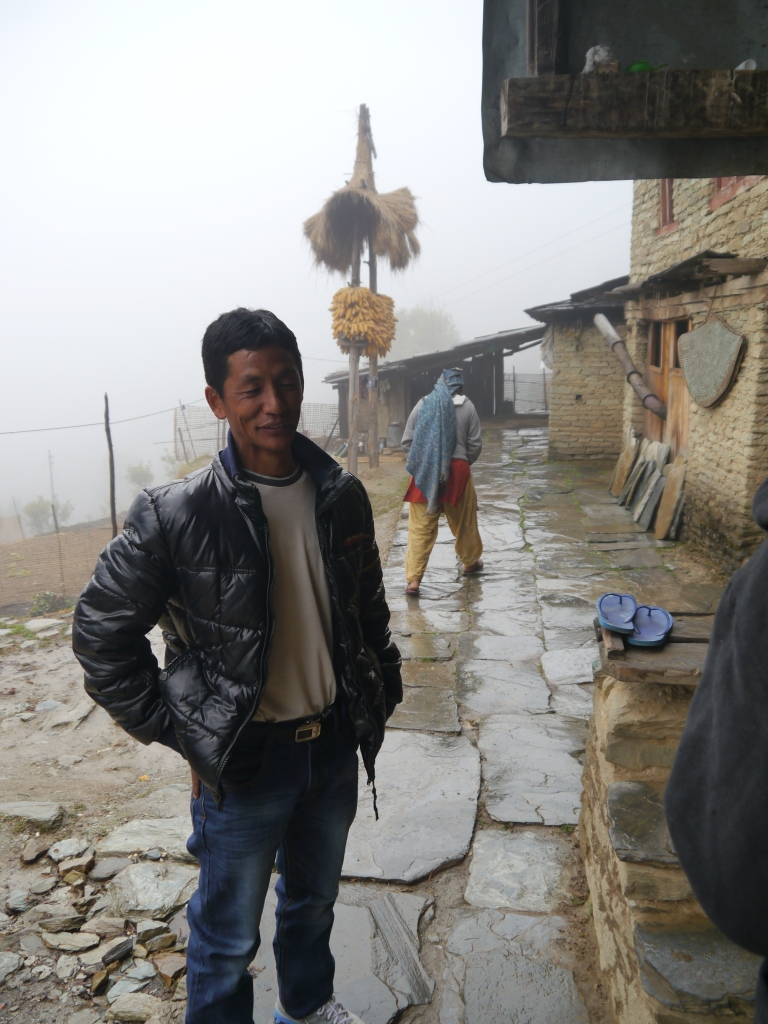
Pooni insisted we try his ‘Nangi wine’ – a corn-based spirit that thankfully made me so wonky that I forgot about the bruises along the left side of my body and my partially-crushed vertebrae. We slept well in thickly-quilted beds, the wind peacefully whistling through the gaps in Pooni’s walls.
Opening the shuttered windows the next day after the charming novelty of being awoken by a cockerel, we found that the cloud that had smothered us the previous evening was back. And it had brought friends.
Pooni was clattering about in his shed by the time we’d pulled on every layer of clothing for what was going to be our hardest day of the trek. He emerged beaming and presented Aneirin and I with two battered and bent umbrellas for the next leg of our journey. We accepted them as if they were gifts from Galadriel. We had no idea that this meagre provision might well serve to save our lives.
We left our host a bottle of whiskey and some rupees hidden slyly in our beds and squelched up into the clouds in high spirits and only slightly damp socks. An hour later, at around 2,700m, we came across a forgotten shrine that marked the beginning of a giant rhododendron forest; a nearby rock painted with a blue and white stripe signalled the start of the ‘upper Annapurna’ area. I reached for my camera just as the gentle pattering on my umbrella became a deafening hammering. It had started hailing. Hard. We quickly touched the shrine, made our peace with the mountain, and ducked into the drooping mouth of the forest.
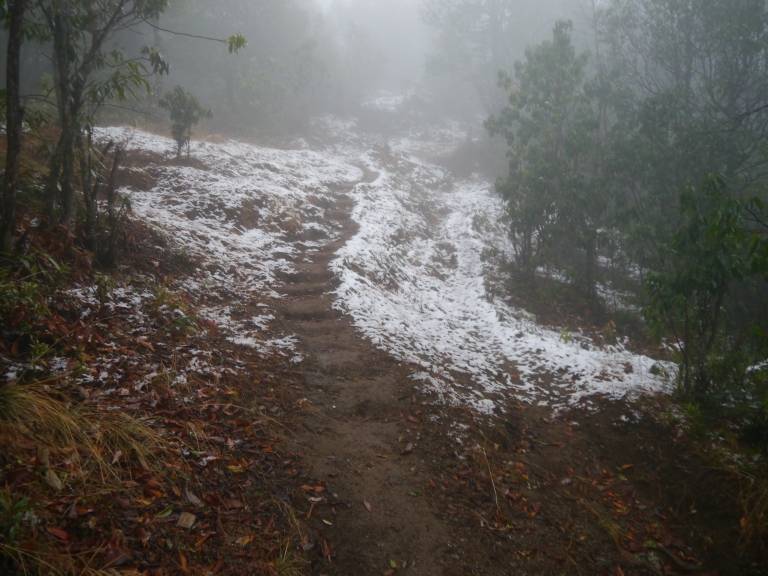
We walked mutely into the darkness, silently shitting ourselves due to the unprecedented precipitation. We were not prepared for this. It wasn’t until the first mini-summit that we both turned around and peered back downhill to check on the hail. We froze. What we saw at the end of the tunnel was fury incarnate.
Golf ball-sized hail had the trees behind us contorting madly; every branch shivered erratically like a disturbed spider’s web, shuddering from the mouth of the forest towards us. Leaves and twigs were raining down in front of a fierce white light, made blinding by worryingly frequent bursts of lightning. The sound of noise was subdued but terrifying. A white sort of spirit seemed to be reaching into the gloom to claim us, swirling with captivating tranquillity as the forest wailed mournfully from all sides. The shrine and the marker stone were totally invisible: engulfed within five minutes.
Aneirin and I shared a glance. Our mouths were curled into half-grins, but we both knew that the stakes had just been upped. I winced as an unimaginably deep rumble penetrated the pressing quiet.
We thought at the time that it was thunder.
We were wrong.
Electing to press on at least to the end of the forest in the faint hope that the hail storm might be a concentrated pocket, we turned from the chaos behind us and walked into the mysterious void ahead.
We’d only taken a few steps, Aneirin forging through the branches, when a loud crack from above punctuated the white noise of the storm. A huge branch came tumbling from the heavens and a muffled whelp from ahead confirmed the inevitable: it had landed directly on Aneirin’s head.
I didn’t have time to laugh and/or examine Aneirin’s potential corpse as, at that moment, a group of Swedish trekkers with sherpas came from around a corner and began filing past us, each one nodding gravely as if we were about to take their place at the front line of the Somme.
As Aneirin struggled to his feet and reclaimed his mangled and now virtually useless umbrella, the group’s guide told us they’d started in Nangi that morning too and recommended we beat a hasty retreat with them. Speaking for a dazed Aneirin, I told him we were made of sterner stuff and showed him our tattered map, pointing at Poon Hill: the 3,400m summit that we were aiming at. He looked us up and down as if to say ‘you two are a pair of cretins’ and bestowed upon us our second gift of the day: large plastic overalls that would provide a thin layer of waterproofing.
We soon discovered why the Swedes had turned back. Just around the corner, the forest had started giving up. The elements had beaten it into a sort of vegetation smoothie that hung limp in surrender to the cruel white light of the mountain. The creaks and snaps of old branches crackled around us. With hunched shoulders and angled umbrellas, we pushed into the tempest and heaved our bodies through the ever-rising heaps of snow, still somehow buoyed by a naïve sense of adventure.
As we climbed still higher into the heavens, the snow rose with us. 6 inches, 8 inches, 12 inches; soon we were measuring the depth of snow with parts of our anatomy. It was three hours since we’d left Pooni and his endless supply of chai and wine, but exposed on the mountainside his cosy fire seemed a world away. We felt utterly isolated. Both of us were covered in a cloak of snow that somehow managed to cling to our plastic protection. Our umbrellas were dying in the line of duty. The air was thin. We were running low on biscuits.
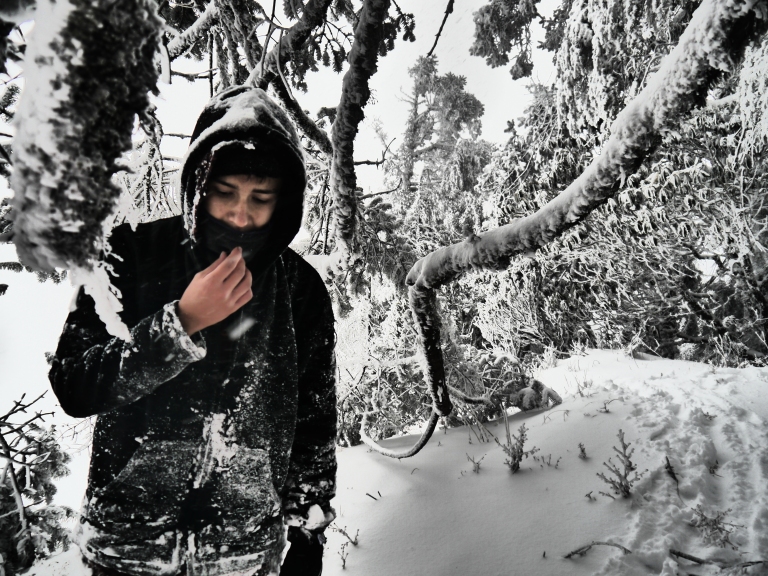
It was also at this point that we realised the flashes of lightning did not match the terrific rumbles that we’d taken as thunder. When I realised, I very nearly put the ‘poo’ in ‘Poon Hill.’
That deep, guttural groan: that was the sound of tonnes of snow flowing down the mountainside. The sound of avalanches.
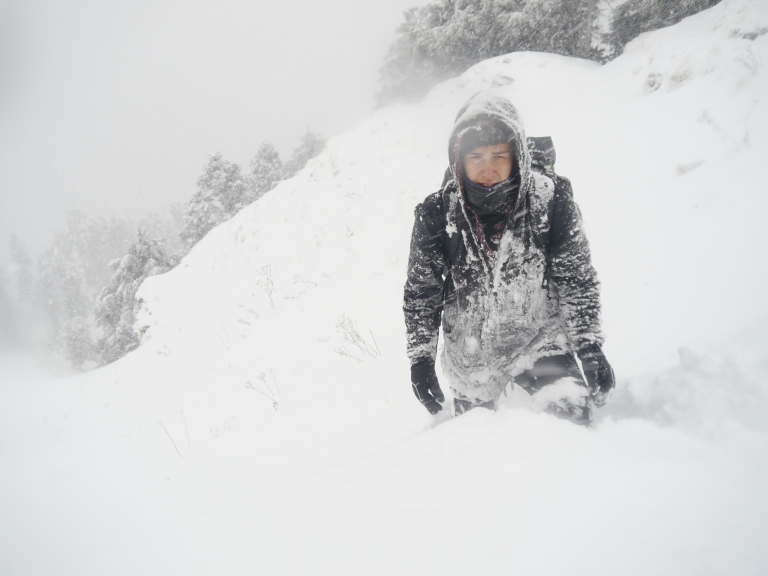
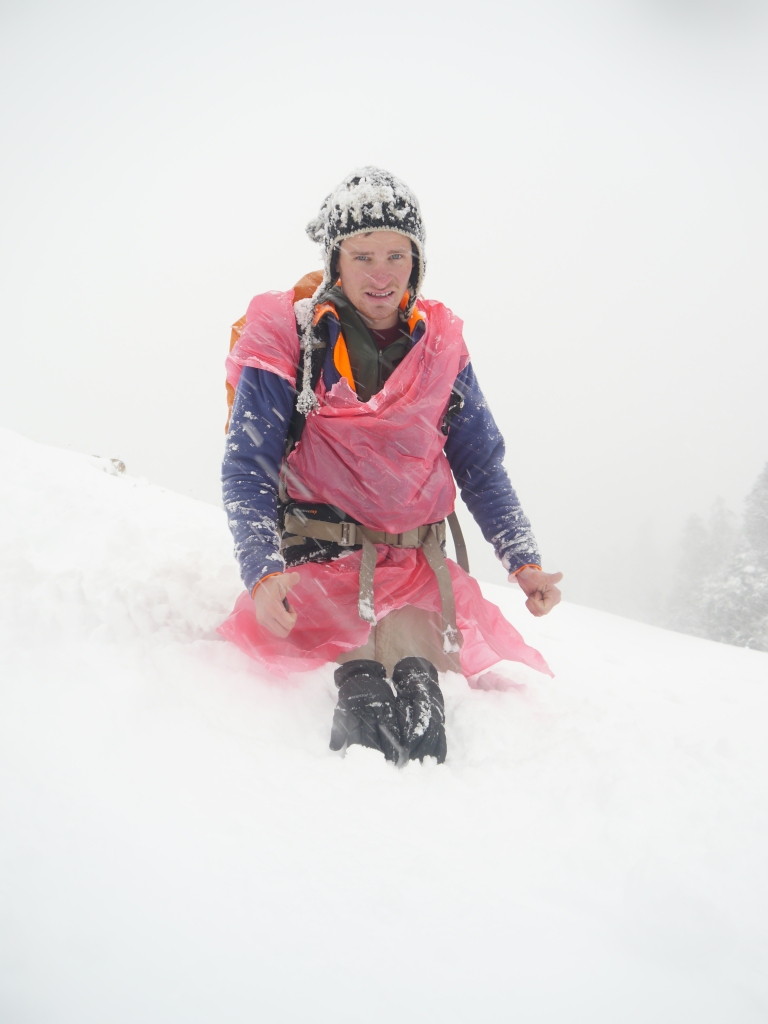
With each step sinking deeper into the newly-laid snow, we fought on, eventually surfacing on the pass that the map had foretold. 3,000m above sea level, we had emerged onto the most challenging part of the trek. A little hut, no more than a roof with 4 wooden sides and some benches inside, stood out against the surrounding white. We waded the 50m to its entrance gratefully, a hip-deep trench forming in our wake. Inside this relative sanctuary, we consulted our map. We were in a clearing that on a normal day would have been incredibly picturesque. Unfortunately for us, the churning clouds were now so thick that we had no picture of our surrounding topography.
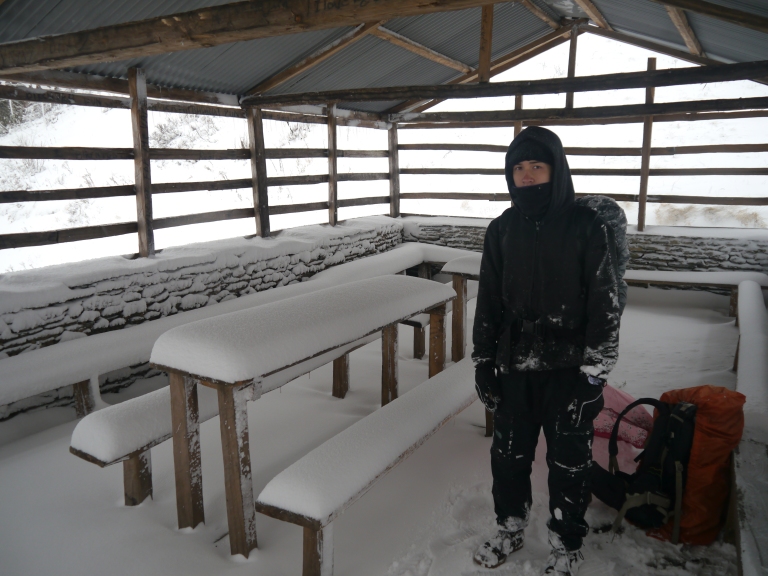
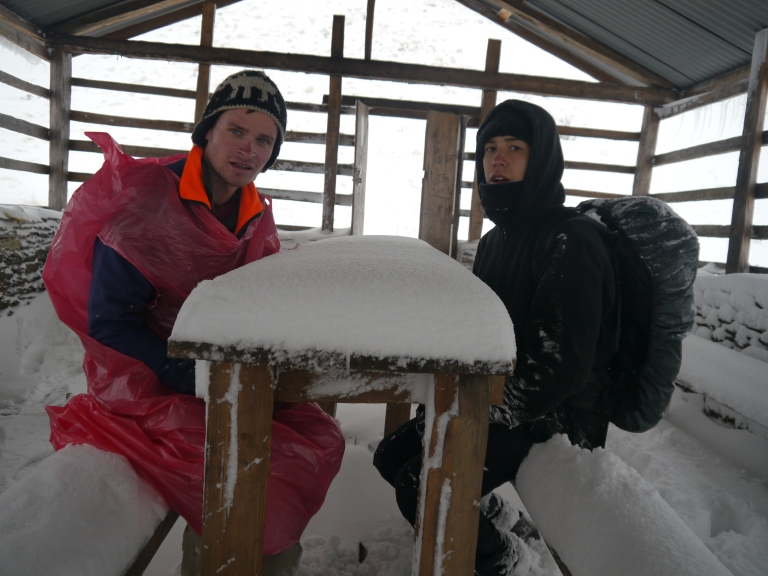
Outside the hut, there was only white.
The map was useless.
As we stared blankly at the map, I tuned into the white noise around us. I slowly began separating the sounds: the terrific roar of more avalanches. The splintering of trees. The howl of the wind. The hut’s roof creaking. The crashes of thunder. It was pandemonium. I looked up at Aneirin, grimacing. We were both beginning to realise that we’d waded blindly into the sort of storm that rages until all life is smothered.
We were four hours from Nangi and two from the next village on our trek. Given the circumstances, we didn’t know whether it would be safer to continue or retreat. We eventually decided to leave our bags in the hut and scout together for signs of the route. Alarmingly, the trench we’d left was already filling up as we pushed slowly through the snow, taking turns to forge a path in hope of finding a ridge. There were three ridges on the map – only one led to the safety of civilisation. An hour later, we found a ridge.
We formed a solemn pact to admit defeat if the ridge proved to be the wrong one, retrieved our bags, and began the torturous climb.
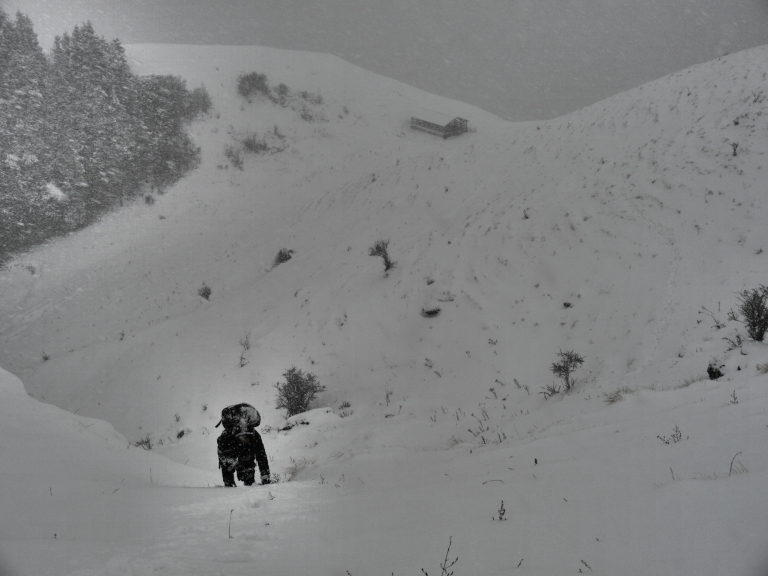
The short ascent took us over an hour and utterly drained us of our last vestiges of energy and hope. We managed to shuffle, crawl, roll, slide and grab our way through the snow and up the mountainside, but at the top we both knew we couldn’t go on. I scouted out for a route anyway while Aneirin removed his boot to see if his toes were still there. No luck for me, but at least Aneirin still had toes. It was decided then.
There, sheltering under a fallen tree on the top of a blustery ridge at 3,200m, with the full ferocity of nature tearing through the hills, we had our minds made up for us. The trek was over. Our best hope was to retrace our steps as quickly as possible, before our tracks faded into the smooth, unnerving, all-encompassing white.
We made it down, on our arses mostly, in just over two hours. In the early evening darkness, the storm spat us out just below the snowline, on the outskirts of Nangi. As quickly as the storm had escalated, it was over. We stumbled, dazed and shivering madly, nursing several more injuries and two unrecognisable umbrellas, towards Pooni’s small abode.
Pooni was waiting outside for us. For the split second before he saw us, I caught the look of concern on his face. And then he saw us and smiled, and took our bags and chucked our umbrellas to one side and gave us tea and wine and rice and curry and blankets and shelter, and won our hearts all over again.
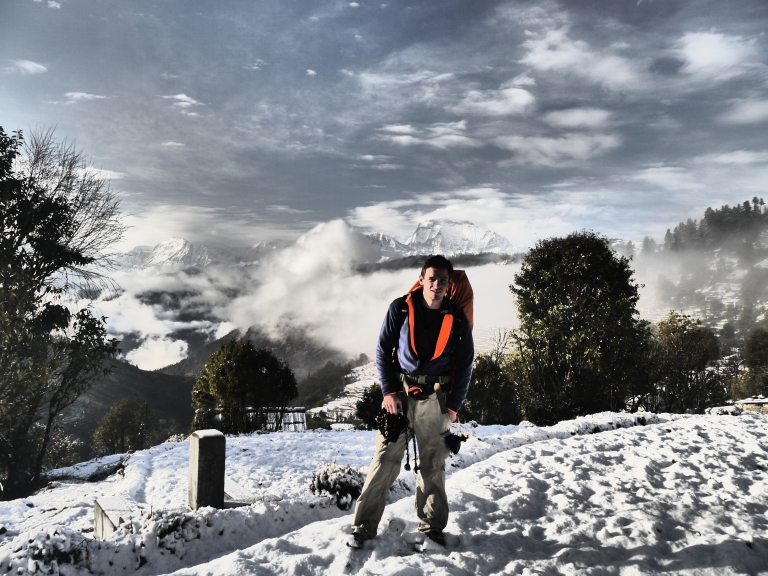
Call us irresponsible or stupid, but that trek proved two things to me.
One
There does remain, somewhere on this earth, the last vestiges of impenetrable wilderness, of freakish nature and paradise all wrapped into one. The toxic reach of humanity is, for the moment, limited.
Two
I was reminded that, when there is no hope or life or happiness left in your body, when the world has issued you a hard slap in the face, something as simple as the smile of a fellow human can melt the most frozen of bodies, and warm the most dejected of hearts.
I have never felt so alive.
– Alex
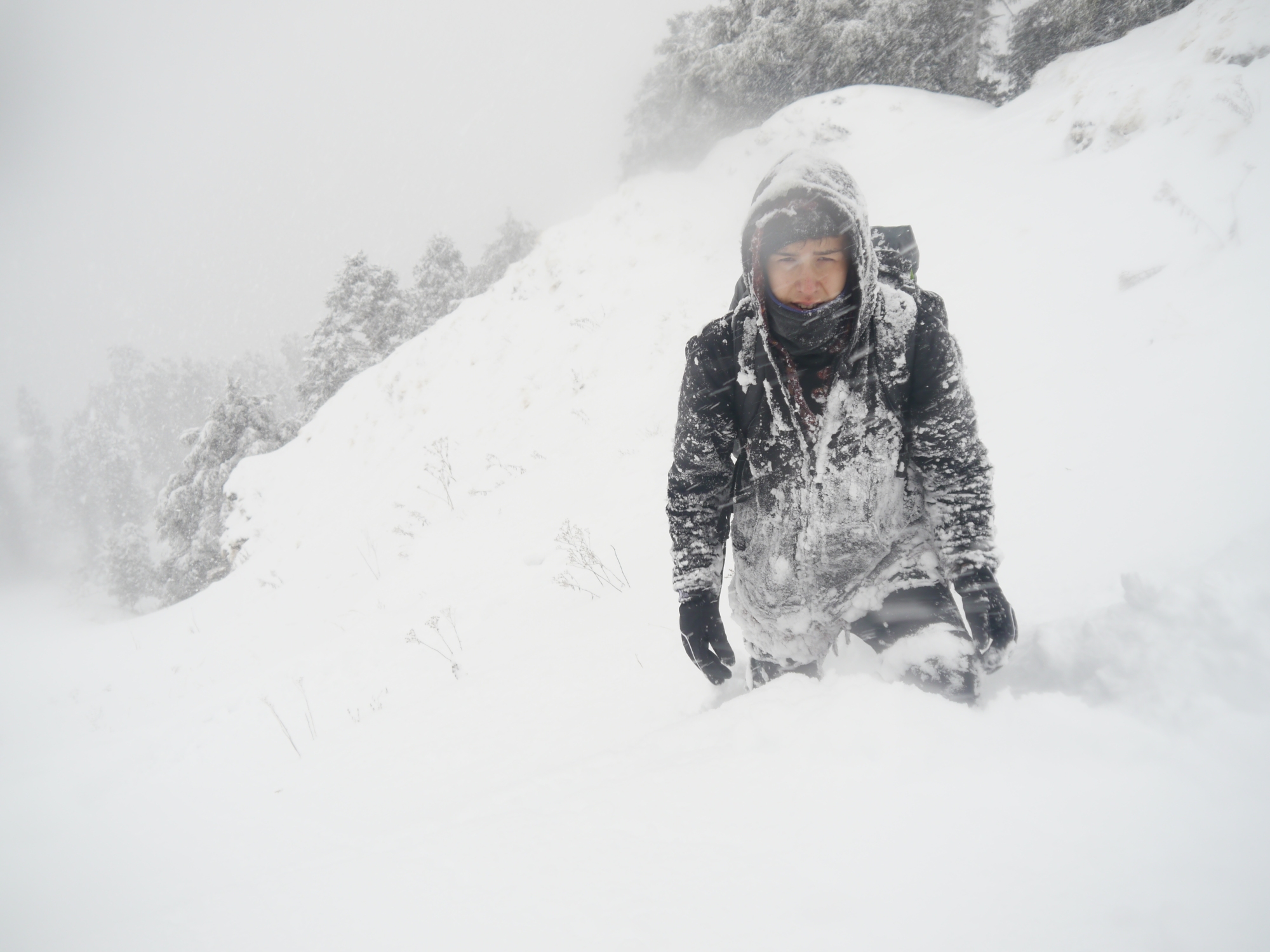
Very slick tale, your writing is all class!
Thanks! Remember reading your favela gunfight story a while back… what a great read! Just caught up on grandma in Amsterdam too – hilarious stuff.
Keep up the blogging!